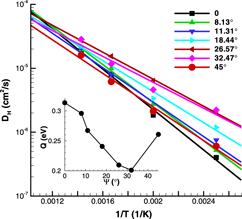Crossref Citations
This article has been cited by the following publications. This list is generated based on data provided by
Crossref.
Shim, Jae-Hyeok
Ko, Won-Seok
Suh, Jin-Yoo
Lee, Young-Su
and
Lee, Byeong-Joo
2013.
Atomistic simulation of hydrogen diffusion at tilt grain boundaries in vanadium.
Metals and Materials International,
Vol. 19,
Issue. 6,
p.
1221.
Osman Hoch, B.
Metsue, A.
Bouhattate, J.
and
Feaugas, X.
2015.
Effects of grain-boundary networks on the macroscopic diffusivity of hydrogen in polycrystalline materials.
Computational Materials Science,
Vol. 97,
Issue. ,
p.
276.
Yu, Mengshan
Xing, Xiao
Zhang, Hao
Zhao, Jiaxi
Eadie, Reg
Chen, Weixing
Been, Jenny
Boven, Greg Van
and
Kania, Richard
2015.
Corrosion fatigue crack growth behavior of pipeline steel under underload-type variable amplitude loading schemes.
Acta Materialia,
Vol. 96,
Issue. ,
p.
159.
Xing, X.
Chen, W.
and
Zhang, H.
2015.
Prediction of crack propagation under cyclic loading based on hydrogen diffusion.
Materials Letters,
Vol. 152,
Issue. ,
p.
86.
Song, H.Y.
Zhang, L.
and
Xiao, M.X.
2016.
Molecular dynamics simulation of effect of hydrogen atoms on crack propagation behavior of α -Fe.
Physics Letters A,
Vol. 380,
Issue. 48,
p.
4049.
Adlakha, I.
and
Solanki, K. N.
2016.
Critical assessment of hydrogen effects on the slip transmission across grain boundaries inα-Fe.
Proceedings of the Royal Society A: Mathematical, Physical and Engineering Sciences,
Vol. 472,
Issue. 2185,
p.
20150617.
Xing, Xiao
Chen, Weixing
and
Zhang, Hao
2017.
Atomistic study of hydrogen embrittlement during cyclic loading: Quantitative model of hydrogen accumulation effects.
International Journal of Hydrogen Energy,
Vol. 42,
Issue. 7,
p.
4571.
Hamza, Mohamed H.
Hendy, Mohamed A.
Hatem, Tarek M.
and
El-Awady, Jaafar A.
2018.
Impact of angular deviation from coincidence site lattice grain boundaries on hydrogen segregation and diffusion in α-iron.
MRS Communications,
Vol. 8,
Issue. 3,
p.
1197.
Mohammadzadeh, Roghayeh
and
Mohammadzadeh, Mina
2018.
Effect of grain boundary misorientation on the apparent diffusivity in nanocrystalline aluminum by atomistic simulation study.
Journal of Applied Physics,
Vol. 124,
Issue. 3,
Xing, Xiao
Zhou, Jiayu
Zhang, Shouxin
Zhang, Hao
Li, Zili
and
Li, Zhenjun
2019.
Quantification of Temperature Dependence of Hydrogen Embrittlement in Pipeline Steel.
Materials,
Vol. 12,
Issue. 4,
p.
585.
Xing, Xiao
Zhang, Hao
Cui, Gan
Liu, Jianguo
and
Li, Zili
2019.
Hydrogen inhibited phase transition near crack tip – An atomistic mechanism of hydrogen embrittlement.
International Journal of Hydrogen Energy,
Vol. 44,
Issue. 31,
p.
17146.
Li, Xinfeng
Ma, Xianfeng
Zhang, Jin
Akiyama, Eiji
Wang, Yanfei
and
Song, Xiaolong
2020.
Review of Hydrogen Embrittlement in Metals: Hydrogen Diffusion, Hydrogen Characterization, Hydrogen Embrittlement Mechanism and Prevention.
Acta Metallurgica Sinica (English Letters),
Vol. 33,
Issue. 6,
p.
759.
Xing, Xiao
Deng, Gonglin
Zhang, Hao
Cui, Gan
Liu, Jianguo
Li, Zili
Wang, Bingying
Li, Shouqin
and
Qi, Chao
2020.
Molecular Dynamics Studies of Hydrogen Effect on Intergranular Fracture in α-Iron.
Materials,
Vol. 13,
Issue. 21,
p.
4949.
Drexler, A.
Siegl, W.
Ecker, W.
Tkadletz, M.
Klösch, G.
Schnideritsch, H.
Mori, G.
Svoboda, J.
and
Fischer, F.D.
2020.
Cycled hydrogen permeation through Armco iron – A joint experimental and modeling approach.
Corrosion Science,
Vol. 176,
Issue. ,
p.
109017.
Xing, Xiao
Cheng, Ran
Cui, Gan
Liu, Jianguo
Gou, Jinxin
Yang, Chao
Li, Zili
and
Yang, Feng
2021.
Quantification of the temperature threshold of hydrogen embrittlement in X90 pipeline steel.
Materials Science and Engineering: A,
Vol. 800,
Issue. ,
p.
140118.
Drexler, Andreas
Domitner, Josef
and
Sommitsch, Christof
2021.
Advances in Hydrogen Embrittlement Study.
Vol. 143,
Issue. ,
p.
87.
Drexler, A.
Bergmann, C.
Manke, G.
Kokotin, V.
Mraczek, K.
Pohl, M.
and
Ecker, W.
2021.
On the local evaluation of the hydrogen susceptibility of cold-formed and heat treated advanced high strength steel (AHSS) sheets.
Materials Science and Engineering: A,
Vol. 800,
Issue. ,
p.
140276.
Dong, Linshuo
Wang, Shuize
Wu, Guilin
Gao, Junheng
Zhou, Xiaoye
Wu, Hong-Hui
and
Mao, Xinping
2022.
Application of atomic simulation for studying hydrogen embrittlement phenomena and mechanism in iron-based alloys.
International Journal of Hydrogen Energy,
Vol. 47,
Issue. 46,
p.
20288.
Zhang, Buyu
Asta, Mark
and
Wang, Lin-Wang
2022.
Machine learning force field for Fe-H system and investigation on role of hydrogen on the crack propagation in α-Fe.
Computational Materials Science,
Vol. 214,
Issue. ,
p.
111709.
Das, Tuhin
Chakrabarty, Rohan
Song, Jun
and
Yue, Stephen
2022.
Understanding microstructural influences on hydrogen diffusion characteristics in martensitic steels using finite element analysis (FEA).
International Journal of Hydrogen Energy,
Vol. 47,
Issue. 2,
p.
1343.
